Organic Tree Care: Natural Methods for Disease Prevention
Organic Tree Care: Natural Methods for Disease Prevention
Organic tree care seeks to provide the best in tree care without the use of synthetic chemicals, pesticides, or fertilizers. The benefits of choosing organic are many, including being better for the trees, the environment, and the health of the humans and animals in the area.
It does take some practice and education to use organic methods effectively, though. The process is simpler for small home gardens than for larger agricultural projects, but there is still a learning curve. That is why we offer this helpful introduction to eco-friendly tree care.
Benefits of Organic Gardening and Tree Care
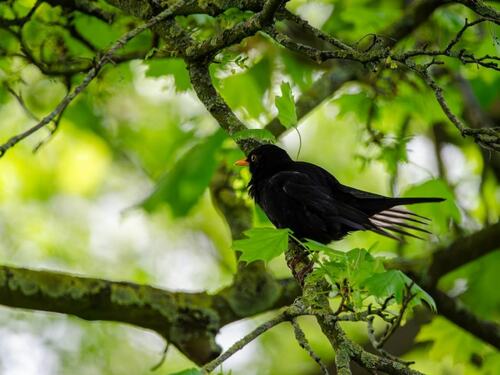
A Blackbird Perches in a Tree – Photo by ArweltAtty Attila
Why choose organic? A few of the key benefits of organic tree care include:
- Nontoxic: Organic options are safer for plants, people, and animals.
- Improves soil development: The methods used in sustainable landscaping build up the nutrients and biodiversity of the soil, which leads to improved health for all the plants in the area.
- Encourages insect biodiversity: Instead of wiping out every insect in the area, organic methods discourage problem insects while leaving beneficial insects alone.
- Discourages bad organisms: Increased biodiversity maintains balance in the soil and among insects, which discourages the overdevelopment of bad organisms.
- Fewer greenhouse gas emissions: Organic products are created using more natural methods and fewer petrochemical products.
- Helps small and local business growth: The profit margins on organic products are less substantial than petrochemical products, which makes manufacturing them less appealing to mega corporations—meaning most of what you purchase supports smaller businesses.
Organic Care Methods
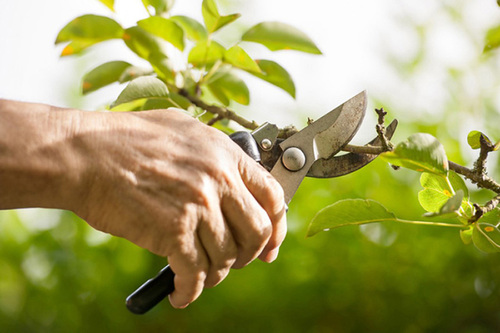
A Small Branch Being Pruned as Part of Organic Tree Care
There are many organic care methods you can use on your trees, shrubs, and other plants. Some of the most common include:
Right Tree, Right Place
One of the most effective ways to ensure healthy tree growth is to pick the right tree for the location. For example, a Japanese elm will likely thrive in the Pacific Northwest of the United States. But if you try to plant the same tree in Scottsdale, Arizona, you are going to have a tough time keeping it healthy.
Some trees are much more adaptable than a Japanese elm. Some coniferous trees can do well in multiple locations throughout the world. But even the most durable trees are going to perform best in a location that hits the sweet spot for moisture, humidity, sun exposure, temperature, and other factors.
Soil Health
Most homes are not built in river valleys or other areas where soil quality is high. In fact, suburban developments can have soil that is significantly lacking in nutrients and biodiversity. But even if you are planting in an area with great soil, the nutrients will eventually be used up by your plantings. That’s why focusing on developing soil health is one of the primary focuses of organic gardening.
Improving soil health can be one of the most enjoyable parts of organic tree care. It’s a long-term process that can include composting, adding soil amendments such as liquid organic matter, mulching, and other techniques. It’s not a quick process, but over the months and years, you can build luxuriant, nutrient-rich soil whether you are in a suburb, on a mountaintop, or anywhere in between.
Pruning
Pruning is another technique that can be a lot of fun and very effective for helping improve tree health. The key is to make sure you are pruning at the right time and in the right way. In most cases, it’s best to prune in winter. During winter, trees go dormant, withdrawing energy and sap. Since the plant is dormant, the cuts you make are not as stressful to the tree. Many insects and bacteria that would be attracted to a wounded tree are also dormant during winter. It’s also much easier to see the structure of the branches when the leaves have fallen. You can prune more accurately because of this.
When spring arrives again, the tree can use its stored energy to heal the cuts and generate growth in the direction that you encourage.
Natural Pesticides
Chemical pesticides do a great job of eliminating pests—unfortunately, they tend to kill beneficial organisms as well. The organic approach strives to be more surgical in the removal or discouragement of pests. Instead of destroying every insect in the area, it focuses on doing a minimal amount of damage to achieve the desired result.
Biological control, often called biocontrol, takes advantage of natural predators to hold down populations of problem pests. Only a small number of insects are actually pests, with the vast majority being either beneficial or benign to your trees. A great example of biocontrol is using ladybugs to control aphids. Release a bag of ladybugs in your garden and they can do a lot to keep down aphid populations—all without the use of toxic pesticides.
Biological controls are not limited to insects, either. A popular spray pest control solution called Bt is organic and very safe to use. It uses bacteria known as Bacillus thuringiensis to kill pests. It’s a natural tree disease prevention tool that’s a favorite among organic growers.
Seasonal Organic Tree Maintenance
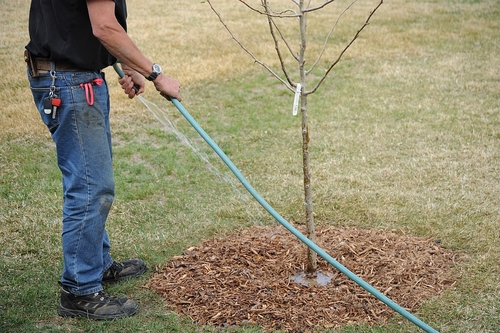
A Young Tree Being Watered in Summer
Adapting your tree care practices to the seasons is especially important when you want to use organic methods. Working with the seasons is the most efficient way to get the results you want because things like the weather, temperature, and tree growth patterns are working with you.
Winter
Winter is the ideal time to prune your trees. They are dormant, and that lowers the risk of diseases spreading through the cuts. It also sets trees up for a big burst of growth when spring hits. Cut off damaged, broken, and diseased branches.
Trees need protection from winter weather. Mulch around the base of the tree to keep the roots from freezing. Brush heavy snow off of the branches to reduce the risk of breakage.
Spring
Spring is a great season to plant new trees due to the typically mild weather and softened soil. It’s good to get tree roots established before the summer heat.
Now is also a good time to fertilize trees because they are getting ready to start growing. Organic fertilizers and soil amendments are ideal choices.
Summer
This is usually when the weather dries up, which can be hard on trees. Establish a regular watering schedule to keep them from getting too thirsty. Slow, steady watering is better because it allows water to reach the roots.
Diseases and infestations are common during summer, so keep an eye out for problems. You can address these issues with natural treatments designed specifically for the condition.
Fall
Fall is the season to mulch again using organic mulch like shredded bark or wood chips. Leave a few inches of open air between the trunk and the mulch to discourage diseases. Fall can be a good time to plant trees as well. If you missed planting in spring, now is the time to do it. Just be sure to plant early enough in fall so the roots can get established before winter.
Common Myths About Organic Tree Care
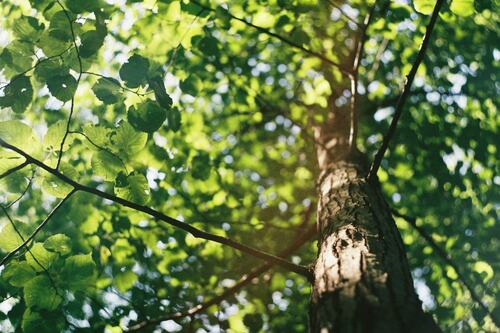
A Lush, Healthy Tree Viewed from Below – Photo by David Vig on Unsplash
Quite a few myths are going around about organic tree care. Fortunately, they are easy enough to debunk. Let’s look at some of the most common:
Organic tree care is expensive.
Organic gardening has become so popular that there are plenty of low-cost options out there now. You can also get many of the things you need, like fertilizer and mulch, from recycling centers that sell it cheaply.
Organic tree care is time-consuming.
It does take time to learn the ins and outs of organic methods. But once you know them, you know them and can use them time and time again. Organic landscapes also tend to take care of themselves once you get them established and balanced.
Organic tree care isn’t any better than conventional.
There are so many benefits that come from an organic approach to tree care. Soil improves, insect diversity goes up, birds come back, and other plants start to thrive. An organic garden can become much more vibrant and alive than a rigidly controlled synthetic one.
Recommended Organic Products and Tools
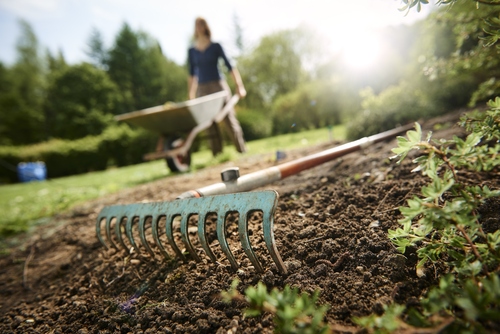
A Woman Uses a Rake and Wheelbarrow for Organic Tree Care
Let’s hop right into it:
- Fertilizers: There are many organic fertilizers for tree health, but always make sure to choose those approved by the Organic Materials Review Institute (OMRI) .
- Pest control: Neem oil and diatomaceous earth are powerful options for controlling pests that are quite affordable. You can also make your own homemade organic tree sprays.
- Tools : You will want to have a shovel, rake, planting knife, water hose, broad fork, pickaxe, wheelbarrow, pruners, and long-handled pruning loppers.
- Education: There is plenty of good information online, but a solid paper manual on organic tree care can be invaluable.
FAQ
Some of the most common questions we hear about organic tree care include:
What is the definition of “organic”?
According to the Merriam-Webster dictionary: “Produced with the use of feed or fertilizer of plant or animal origin without employment of chemically formulated fertilizers, growth stimulants, antibiotics, or pesticides.”
What are the best natural pesticides?
It can depend on the situation, but some of the most common are Bacillus thuringiensis (Bt) and diatomaceous earth. Neem oil is also quite effective.
Is it easy to care for trees organically?
Yes! It just takes a little education and practice to become proficient.
Contact Us to Learn More About Caring for Trees Organically!
Our team is here to help you protect your beautiful trees in an eco-friendly way. Contact Arborist Now to discuss your specific tree care needs.
We may receive affiliate compensation for some of the links below at no cost to you if you decide to make a purchase.


